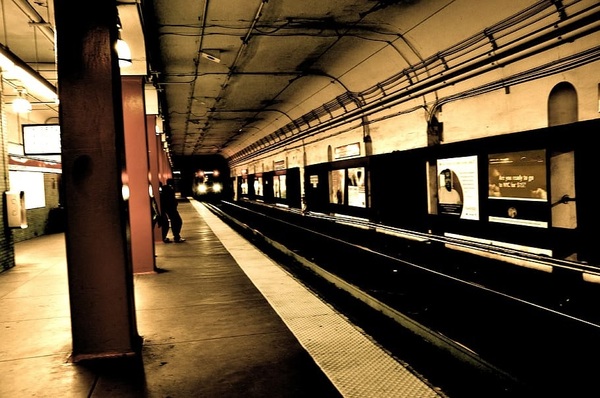
–>
May 18, 2023
The New York City subway incident in which former Marine Daniel Penny, whose chokehold inadvertently killed career criminal and homeless vagrant Jordan Neely quickly became front-page news. Matters exploded when Alvin Bragg, Manhattan’s Soros-funded district attorney, charged Penny with second-degree manslaughter. Presidential hopeful Ron DeSantis made reference to at a campaign rally, and Penny’s defense fund has thus far raised more than two million dollars from 42,000 contributors Hard to say where it will end, but the incident has obviously touched a public nerve. There’s something about the episode that transcends the simple facts of a good Samaritan’s intervention going wrong and a progressive local DA stirring the racial pot.
‘); googletag.cmd.push(function () { googletag.display(‘div-gpt-ad-1609268089992-0’); }); document.write(”); googletag.cmd.push(function() { googletag.pubads().addEventListener(‘slotRenderEnded’, function(event) { if (event.slot.getSlotElementId() == “div-hre-Americanthinker—New-3028”) { googletag.display(“div-hre-Americanthinker—New-3028”); } }); }); }
Most Americans do not ride New York City subways, so the psychological dimension to this incident is not easily grasped. Yet it is this psychological element that makes it important far beyond the bare-bones legal facts.
Regular subway riders — me included — are always aware of certain inescapable realities. These realities come with city life, knowing New York City’s troubled past (remember the film Death Wish?) and having a keen eye for one’s surroundings.
Experienced subway riders know that they are trapped for minimally three minutes, longer on express trains and, occasionally even longer if there’s a track fire, a broken switch, or a stuck train. You are also stuck with all the people on the ten-car train (usually a 100+). Furthermore, though walking between cars is prohibited, people ignore the restriction (doors are unlocked), so forget about choosing only cars with non-threatening fellow passengers. That scruffy vagrant you saw sleeping in the end car before you boarded a crowded middle car may soon be standing over you requesting a “donation.” This is not an airplane with screened passengers, cabin staff, and FAA rules banning unruly passengers. The subway’s unpleasant reality has been made even worse as cops now ignore turnstile jumpers.
‘); googletag.cmd.push(function () { googletag.display(‘div-gpt-ad-1609270365559-0’); }); document.write(”); googletag.cmd.push(function() { googletag.pubads().addEventListener(‘slotRenderEnded’, function(event) { if (event.slot.getSlotElementId() == “div-hre-Americanthinker—New-3035”) { googletag.display(“div-hre-Americanthinker—New-3035”); } }); }); }
Nor is there any police protection while you are trapped. Mayor Eric Adams has flooded the subway with cops, but the bad news is that you only see them outside the train, often chatting while watching their cellphones. Worse, they typically just mill about at the station entrance many yards from subway platforms. In other words, when the next Jordan Neely corners you yelling and screaming, you’re on your own until the next station and then, if lucky, you can exit to summon law enforcement. Ironically, periodic recorded announcements via the car’s PA system advise you that if you need help, the NYPD is only a station away to rescue you.
Being trapped means that you become a captive audience for grubby beggars, mariachi bands, aspiring rappers, “gymnasts” with boomboxes, candy sellers, and multiple other urban “entrepreneurs.” Yes, nobody fears a ten-year old boy hawking Kit-Kats, but it is uncomfortable to lack any escape route when he makes his pitch. And who knows what could happen if you accidentally make eye-contact with a disheveled panhandler strolling from car to car?
It is no wonder, then, that many New Yorkers, especially elderly women, prefer buses, though they are far slower and usually less frequent. A bus can always immediately stop and discharge its passengers to safety, and the driver can see trouble and summon help. Subways may have conductors and motormen, but neither can see and then help a passengers confronted by a wild-eyed nutcase.
 There is a reality here that dare not speak its name. The New York subway, including many dark, deserted passageways, abound with people whose inescapable presence justifiably causes unease. Their presence is excluded from official crime statistics, but their existence projects a reasonable sense of criminal threat. And thanks to liberal DAs like NYC’s Alvin Bragg, their numbers grow. Critically, this unease cannot be mitigated by upbeat reports about declining subway crime or endlessly preaching the joys of diversity. Jordan Neely’s subway “act” was innocently impersonating Michael Jackson, but among his 42 prior arrests was one for assaulting a 67-year old woman whose nose was broken and eye socket fractured (he walked in exchange for 15 months of treatment that he never completed). Paranoia about “the harmless” can sometimes be justified.
There is a reality here that dare not speak its name. The New York subway, including many dark, deserted passageways, abound with people whose inescapable presence justifiably causes unease. Their presence is excluded from official crime statistics, but their existence projects a reasonable sense of criminal threat. And thanks to liberal DAs like NYC’s Alvin Bragg, their numbers grow. Critically, this unease cannot be mitigated by upbeat reports about declining subway crime or endlessly preaching the joys of diversity. Jordan Neely’s subway “act” was innocently impersonating Michael Jackson, but among his 42 prior arrests was one for assaulting a 67-year old woman whose nose was broken and eye socket fractured (he walked in exchange for 15 months of treatment that he never completed). Paranoia about “the harmless” can sometimes be justified.
Daniel Penny’s arrest for intervening to stop a clearly deranged career criminal sends a loud message: only a fool would risk being a good Samaritan, especially since the culprit’s unseen physical condition from drug abuse may put him on the edge of death. Nearly everybody remembers drug-addled George Floyd. Chronic addicts may only require a gentle nudge to enter the hereafter. Meanwhile seemingly harmless crazy person may be armed with a gun or knife, and who can predict their reaction, particularly if high on amphetamines. Better to pretend not to notice than risk jail time.
The short-term impact of this legal fiasco will be a decline in subway ridership. Why take the risk when the odds are stacked against you? Uber rides are expensive, but how much is your life worth?
‘); googletag.cmd.push(function () { googletag.display(‘div-gpt-ad-1609268078422-0’); }); document.write(”); googletag.cmd.push(function() { googletag.pubads().addEventListener(‘slotRenderEnded’, function(event) { if (event.slot.getSlotElementId() == “div-hre-Americanthinker—New-3027”) { googletag.display(“div-hre-Americanthinker—New-3027”); } }); }); } if (publir_show_ads) { document.write(“
There is, however, a deeper issue that many Americans may be beginning to sense. Government’s prime responsibility is safety, and without safety, nothing else matters. No urban economy, whether restaurants, concerts, or shopping, can survive if transportation becomes unaffordable. Personal safety is equally vital for family life — why put children at risk? No wonder many fleeing to red states boast, “you don’t have to lock your doors.”
Here’s the takeaway from this New York City subway incident: not only will local government not protect you, but we will make you more vulnerable to a possibly horrific death, and it will make sure that the possibility of this death is a regular feature of your existence. Yes, the municipal government may struggle with picking up the garbage, but it does have the recipe for terrifying you: put you in an escape-proof metal box, release thousands of criminals and nutcases back into the subway, and then ensure that you have no recourse if assaulted. And if you are attacked, nobody will defend you, and don ‘t even think of fighting back, let alone brandishing a weapon. Imagine if Sargent Penny had an AR-15, even if he didn’t use it? And, if by chance, you do resist and win, hundreds of protestors will riot and then demand that you be punished.
This is a battle between human nature versus progressive politics. The survival urge is genetically driven, and progressives like Alvin Bragg prefer a docile, vulnerable, and easy-to-manage population. It’s no different from forcing you to mask up and take the vaccine. The Daniel Penny episode is a public training exercise in domestication and judging by the outpouring of support for the former Marine, lots of people are tired of being forced to submit when cornered.
Recall when Rosa Parks decided that she was sick and tired of being legally required to sit at the back of the bus. Many are now fed up with having to suffer abuse from the crazies and risk being arrested if they fight back. If governments refuse to protect us, we may have no choice but to send in the Marines.
Image: PxFuel
<!–
–>
<!– if(page_width_onload <= 479) { document.write("
“); googletag.cmd.push(function() { googletag.display(‘div-gpt-ad-1345489840937-4’); }); } –> If you experience technical problems, please write to [email protected]
FOLLOW US ON
<!–
–>
<!– _qoptions={ qacct:”p-9bKF-NgTuSFM6″ }; ![]() –> <!—-> <!– var addthis_share = { email_template: “new_template” } –>
–> <!—-> <!– var addthis_share = { email_template: “new_template” } –>





